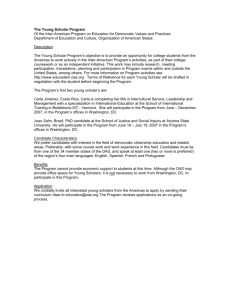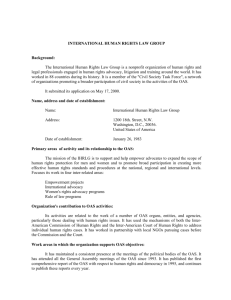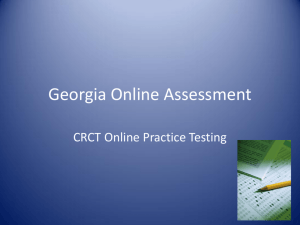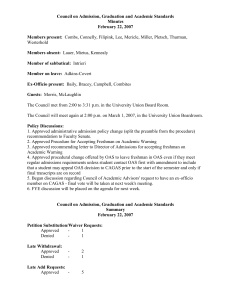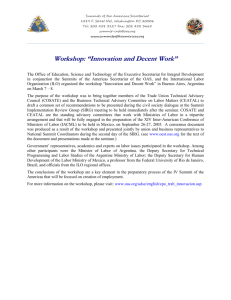CRS Report for Congress Organization of American States: A Primer Summary
advertisement
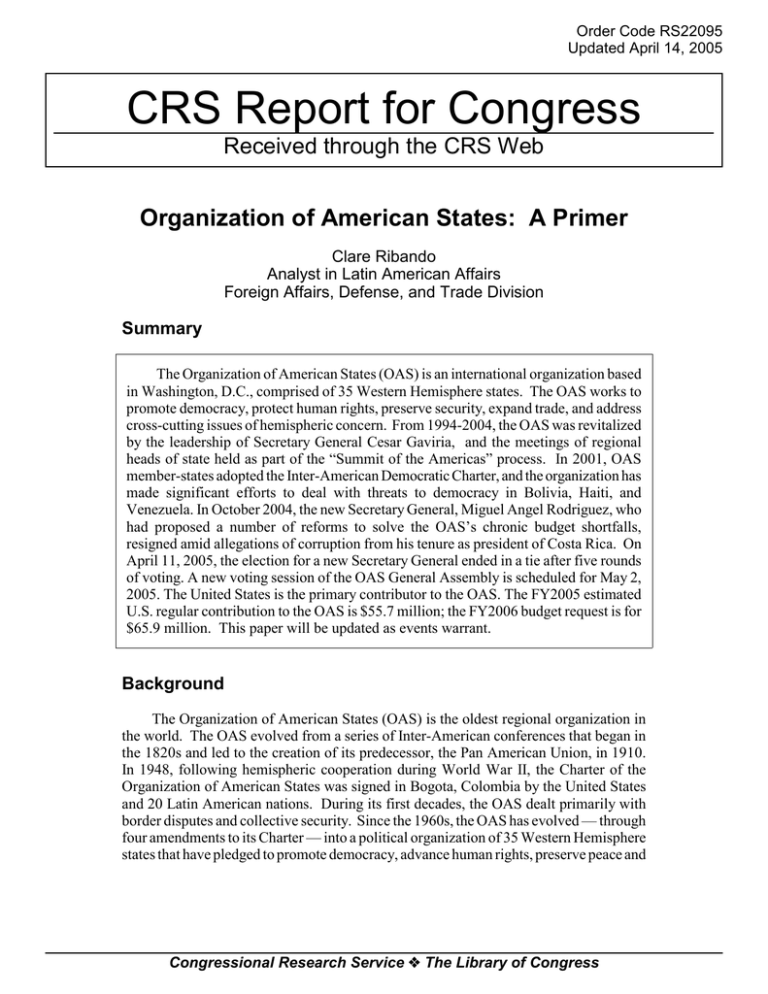
Order Code RS22095 Updated April 14, 2005 CRS Report for Congress Received through the CRS Web Organization of American States: A Primer Clare Ribando Analyst in Latin American Affairs Foreign Affairs, Defense, and Trade Division Summary The Organization of American States (OAS) is an international organization based in Washington, D.C., comprised of 35 Western Hemisphere states. The OAS works to promote democracy, protect human rights, preserve security, expand trade, and address cross-cutting issues of hemispheric concern. From 1994-2004, the OAS was revitalized by the leadership of Secretary General Cesar Gaviria, and the meetings of regional heads of state held as part of the “Summit of the Americas” process. In 2001, OAS member-states adopted the Inter-American Democratic Charter, and the organization has made significant efforts to deal with threats to democracy in Bolivia, Haiti, and Venezuela. In October 2004, the new Secretary General, Miguel Angel Rodriguez, who had proposed a number of reforms to solve the OAS’s chronic budget shortfalls, resigned amid allegations of corruption from his tenure as president of Costa Rica. On April 11, 2005, the election for a new Secretary General ended in a tie after five rounds of voting. A new voting session of the OAS General Assembly is scheduled for May 2, 2005. The United States is the primary contributor to the OAS. The FY2005 estimated U.S. regular contribution to the OAS is $55.7 million; the FY2006 budget request is for $65.9 million. This paper will be updated as events warrant. Background The Organization of American States (OAS) is the oldest regional organization in the world. The OAS evolved from a series of Inter-American conferences that began in the 1820s and led to the creation of its predecessor, the Pan American Union, in 1910. In 1948, following hemispheric cooperation during World War II, the Charter of the Organization of American States was signed in Bogota, Colombia by the United States and 20 Latin American nations. During its first decades, the OAS dealt primarily with border disputes and collective security. Since the 1960s, the OAS has evolved — through four amendments to its Charter — into a political organization of 35 Western Hemisphere states that have pledged to promote democracy, advance human rights, preserve peace and Congressional Research Service ˜ The Library of Congress CRS-2 security, pursue free trade, and tackle difficult problems caused by poverty, drugs, and corruption.1 During the Cold War, the United States often pursued its primary interest in Latin America — preventing the spread of communism — in a unilateral manner. At the same time, many Latin American countries were ruled by military dictatorships that did not share the same policy goals as the United States. By the 1980s, the OAS was widely perceived as a weak institution that was “mired in dissent and inaction.”2 By 1990, the Cold War had ended and the vast majority of OAS member states had returned to democratic rule. As a result of a new, shared commitment to democracy, the OAS developed mechanisms that would enable it to take action to protect democracy in troubled states. Some have praised the “unprecedented multilateral efforts [that] have been undertaken” by the OAS to counter anti-democratic developments in the region.3 Others have noted that while the OAS rapidly responded to several crises in the early 1990s, recent practice since 1997 points to a weakened commitment to take action in a timely and well-planned manner.4 Still others note that OAS efforts have often been hampered by limited resources and by an ongoing tension between the need for collective action and the need to respect state sovereignty.5 Organization. The governing body of the OAS is the General Assembly, which convenes the foreign ministers of all member states annually to make consensus decisions on the structure, funding, and guiding priorities of the organization. The next regular meeting of the OAS General Assembly will be held in Ft. Lauderdale, Florida in June 2005. The Permanent Council, which is composed of ambassadors appointed by the member states, meets regularly at OAS headquarters in Washington, D.C. to direct its ongoing actions. The chairmanship of the Permanent Council rotates every three months, and each member state has an equal vote in the decisions of the Council. Another Council of the OAS, the Inter-American Council for Integral Development, is charged with fighting poverty and promoting economic development. Two of the other bodies that currently report directly to the OAS General Assembly are the Inter-American Juridical Committee and the Inter-American Commission on Human Rights. While the General Assembly and the Permanent Council are political bodies that set broad priorities for the OAS, the General Secretariat implements the ongoing programs and policies of the organization. The General Secretariat is led by the Secretary General 1 All 35 countries in the Western Hemisphere have signed the OAS Charter and are members of the organization. Although Cuba ratified the OAS charter, its government has been excluded from participation in the organization since 1962. 2 Richard E. Feinberg, Summitry in the Americas: A Progress Report, Washington, D.C.: Institute for International Economics, 1997. 3 Andrew F. Cooper, “The OAS Democratic Solidarity Paradigm: Questions of Collective and National Leadership,” Latin American Politics and Society, Spring 2001. 4 Dexter S. Boniface, “A Democratic Norm for the Western Hemisphere?,” Paper presented at the 2004 Latin American Studies Association (LASA) Conference, October 2004. 5 T.A. Imobighe, The OAU (AU) and the OAS in Regional Conflict Management: A Comparative Assessment, Ibadan, Nigeria: Spectrum Books, 2003. CRS-3 and Assistant Secretary General, who are elected by the member states to five-year terms. Specialized departments within the General Secretariat focus on issue areas such as democracy and political affairs, human rights, integral development and security. In October 2004, then-Secretary General Rodriguez issued an executive order which changed the structure of the General Secretariat.6 The structural reforms sought to streamline the organization’s functioning, and better allocate its limited resources (budget and staff) into priority areas that fulfill the OAS mission. Two entities of particular interest to the U.S. government — the Inter-American Drug Abuse Control Commission (CICAD), and the Inter-American Committee Against Terrorism (CICTE) — retained some autonomy, although they are now under the Department of Multinational Security. Funding. The OAS budget consists of a regular fund, as well as specific funds (coming from voluntary country contributions) for special programs. The regular fund supports the General Secretariat and is financed by country quotas. As a result of financial difficulties incurred by many member states and a reluctance to increase quotas, the regular fund has remained at approximately $73.6 million for the past ten years. The United States contributes roughly 59% of the regular fund. For FY2005, the U.S. contribution to the OAS is $55.7 million through the Commerce, Justice, State (CJS) appropriation (Title IV of P.L.108-447). Of the $55.7 million, $45.9 million is for the regular fund, and $9.8 million is to pay tax reimbursements for U.S. employees of the OAS. The FY2006 request for the OAS is for $65.9 million. The increase is to cover the cost of taxes owed for U.S. employees that are likely to retire in the coming year. Since 1997, the OAS has raised specific funds for certain projects and programs in order to supplement gaps in its regular fund. It raised more than $200 million in specific funds between 2000 and 2004. The primary beneficiaries of those funds include the Unit for the Promotion of Democracy, the Secretariat for Conferences and Meetings, CICAD, and the Unit for Sustainable Development and Environment. The United States has made substantial contributions to a few specific funds developed by the OAS through Foreign Operations appropriations. The OAS Fund for Strengthening Democracy supports OAS efforts to promote democracy and the InterAmerican Democratic Charter throughout the region; the FY2005 U.S. contribution is $3 million, while the FY2006 request is for $2.5 million. OAS Development Assistance Programs focus on Summit of the Americas mandates pertaining to economic prosperity, social well being, and environmental health7; the FY2005 U.S. contribution is $4.9 million, while the FY2006 request is for $5.2 million. The OAS De-mining Program (AICMA) works to ensure that the Western Hemisphere is cleared of all land mine devices; the FY2005 U.S. contribution is $1.8 million, while the FY2006 request is for $1.6 million. These contributions to specific funds give the United States significant leverage over the types of projects undertaken by the OAS. 6 Some of the reforms reflected recommendations contained in a Management Study of the General Secretariat issued by Deloitte and Touche in November 2003. An Executive Summary is available at [http://scm.oas.org/pdfs/2003/cp12017e-1.ppt]. 7 The bulk of these contributions support the Inter-American Council for Integral Development (FEMCIDI). FEMCIDI, financed by voluntary contributions from member states and other assets, contributes to national and multinational development projects. CRS-4 Progress on Key Topics Protection of Human Rights. In 1969, the Inter-American Convention on Human Rights was adopted, which sets forth the duties of the two autonomous bodies responsible for the protection of human rights: the OAS Inter-American Commission on Human Rights (IAHCR) based in Washington, D.C., and the Inter-American Court of Human Rights (IAC) based in San José, Costa Rica. The IACHR meets regularly to monitor the human rights situation in the region, organizes conferences and seminars, and submits cases to the IAC for deliberation. In its 2004 human rights report, the IACHR expressed concern about the general situation of human rights in Bolivia, Cuba, Colombia, Ecuador, Haiti, and Venezuela.8 The IAC has seven judges, elected to six-year terms by the General Assembly, who hear cases involving alleged human rights abuses committed by a country against an individual or group. The IAC has asserted jurisdiction over all 35 member states. Promotion of Democracy. Since 1990, the OAS has taken an active role in defending threats to democracy in the Western Hemisphere. In 1990, the OAS created the Unit for the Promotion of Democracy (UPD), now part of the Department for Democratic and Political Affairs, to assist its member states in strengthening democratic institutions and processes. Between 1994 and 2004, the UPD sent 60 observation missions throughout the region to ensure the fairness and transparency of electoral processes. In 2000, the UPD declared Peru’s presidential election to be illegitimate and sent a HighLevel Mission to Peru led by Sec. Gaviria to help resolve the country’s democratic crisis.9 In 1991, the OAS adopted resolution 1080, or the “Santiago Commitment,” instructing the Secretary General to convoke the Permanent Council or the General Assembly in the event of “a sudden or irregular interruption”of the democratic process in a member state, and to act to resolve that conflict. In 1992, the OAS ratified the Washington Protocol to the OAS Charter, becoming the first regional political organization to allow suspension of a member state in the event that its democratically elected government is overthrown by force. The OAS has yet to invoke the Washington Protocol. Before resolution 1080 was superseded in 2001, the OAS limited its use to four instances in which either a military coup, self-coup by an elected President, or severe civil-military crisis occurred. Some observers have criticized the OAS’s failure to invoke resolution 1080 more frequently as in the case of a successful coup against Jamil Mahuad in Ecuador in 2000.10 Others have noted that even in cases when the OAS did act under resolution 1080, such as Paraguay in 1996, its delayed response was of limited consequence.11 8 Available at [http://www.cidh.org/Comunicados/English/2005/8.05.htm]. 9 For two contrasting views on the OAS efforts in Peru, see Andrew F. Cooper and Thomas Legler, “The OAS in Peru: A Model for the Future?”, and Cynthia McClintock, “The OAS in Peru: Room for Improvement,” Journal of Democracy, vol. 12, no. 4, October 2001. 10 11 Boniface, 2004. Arturo Valenzuela, “Paraguay: The Coup That Didn’t Happen,” Journal of Democracy, vol. 8, no. 1, January 1997. CRS-5 On September 11, 2001, the OAS adopted the Inter-American Democratic Charter (IADC). The IADC broadens the mandate of resolution 1080 and states that the OAS will respond to any democratic crisis that involves an “unconstitutional alteration of the constitutional regime”of one of its member states.12 Since 2001, the OAS has employed a combination of technical assistance through the UPD, high-level missions, conflict resolution techniques, multilateral diplomacy, and, multilateral sanctions, in order to respond to democratic crises in countries such as Bolivia, Haiti, Venezuela, and, more recently, Nicaragua. In April 2002, the IADC was invoked when the OAS condemned the “alteration of the constitutional order” in Venezuela that temporarily forced President Chavez from power.13 Although it was utilized in the case of Venezuela, the IADC has been criticized for being vague in defining what conditions constitute a violation of its principles. Those conditions need to be clearly defined, former President Jimmy Carter has said, and automatic responses developed that would help the OAS deal with common violations of the Charter.14 Summits of the Americas. In 1994, the Clinton Administration hosted the first meeting of regional leaders in more than 27 years at the Miami Summit of the Americas. In Miami, hemispheric leaders signed a comprehensive plan of action with 23 separate initiatives. The Miami Summit was followed by regular ministerial-level meetings, as well as three presidential-level meetings: Summit of the Americas II (Santiago, Chile, April 1998), Summit of the Americas III (Québec, Canada, April 2001), and, most recently, the Special Summit of the Americas (Monterrey, Mexico, January 2004).15 Each of the summits has focused on a different topic, affording leaders a unique opportunity to discuss issues of common concern and develop initiatives to resolve them. Nevertheless, due to limited funding given to those initiatives or implementing agencies to carry them out, some observers contend that summit initiatives have become “unfunded mandates” given to the OAS and the Inter-American Development Bank.16 Criticisms aside, the OAS and the Argentine government are gearing up to host the Fourth Summit of the Americas in November 2005 focusing on employment in the hemisphere. Combating Terrorism. In September 2001, the OAS swiftly condemned the terrorist attacks on the United States and invoked the Inter-American Treaty of Reciprocal Assistance (known as the “Rio Treaty”) and pledged to cooperate in counter-terrorism 12 Adopted by the General Assembly at its special session held in Lima, Peru, on Sept. 11, 2001. Available at [http://www.oas.org/main/main.asp?sLang=E&sLink=http://www.upd.oas.org]. 13 In September 2002, the OAS Permanent Council passed a resolution pledging support for the process of dialogue between the government and opposition groups. In 2003, after months of negotiations facilitated by the OAS and the Carter Center, the two sides agreed to a process that would resolve the country’s democratic crisis. See CRS Report RL32488, Venezuela: Political Conditions and U.S. Policy, by Mark P. Sullivan. 14 Address by Jimmy Carter at the Opening Conference of the Lecture Series of the Americas at the Organization of American States, Washington, D.C., January 25, 2005. See [http://www.oas.org/OASpage/press_releases/press_release.asp?sCodigo=E-014/05]. 15 See CRS Report RS21700, Special Summit of the Americas — Monterrey, Mexico, by Clare Ribando. 16 Richard Feinberg et al., “Unfunded Mandates in the Western Hemisphere,” FOCAL, January 2004. Available at [http://www.sice.oas.org/geograph/westernh/Focal.pdf]. CRS-6 efforts. The Inter-American Committee on Terrorism (CICTE), originally established in 1999, was revitalized and strengthened. CICTE has sponsored five regional meetings, and has cooperated on border security mechanisms, controls to prevent funding of terrorist organizations, law enforcement, and counterterrorism intelligence and information. In June 2002, OAS members signed a newly completed Inter-American Convention Against Terrorism, paving the way for increased regional cooperation. Current Issues Budgetary Limitations. The OAS regular fund has been frozen at roughly $77 million for more than 10 years, despite increasing operating expenses. According to exSecretary General Gaviria, the General Secretariat has struggled to “do a great deal more with significantly fewer real resources.”17 The OAS has cut staffing, streamlined its functioning, and rented out part of its building to other international agencies in order to attempt to cover its operating expenses. Without specific funds to supplement its regular budget, some feel the OAS would no longer be able to fulfill its mission. Some analysts have called for the United States and other member governments to strengthen the financial solvency of the OAS.18 Others have questioned whether the OAS, an organization that has been criticized for being slow and inefficient, merits increased funding. In 2003, Brazil, with support from the United States, called for a 3.5% country quota increase, a proposal that was eventually rejected. Quota increases are unlikely to be supported as some countries have been unable to keep up with their current quotas. Search for New Leadership. Since Miguel Angel Rodriguez resigned in October 2004, the OAS has been under the leadership of Assistant Secretary General Luigi Einaudi from the United States. On April 8, 2005, Francisco Flores, the former president of El Salvador, withdrew from the race for the position of Secretary General of the OAS. The remaining candidates for the position of Secretary General are José Miguel Insulza, the Chilean interior minister, and Luis Ernesto Derbez, the Mexican foreign minister. Insulza has focused his campaign on the need for the OAS to help strengthen member countries’ institutions. Derbez has emphasized the importance of addressing the needs of small and less-developed countries in the region. On April 11, 2005, the OAS General Assembly met to elect a new Secretary General. Since each of the 34 countries has an equal vote in the election for Secretary General, the winner needed to garner at least 18 votes. After five rounds of voting by secret ballots, the election ended in a tie, with Derbez and Insulza each receiving 17 votes. The OAS General Assembly will reconvene on May 2, 2005 in order to conclude the voting process. 17 Cesar Gaviria, The OAS in Transition: 1994 - 2004, Washington, D.C.: Organization of American States, 2004. 18 “Report of the U.S. Policy Task Force: Agenda for the Americas 2005,” Inter-American Dialogue, March 2005. See [http://www.iadialog.org/publications/2005/winter/ agenda_2005.pdf]

